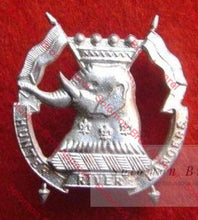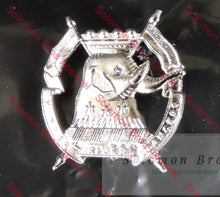12/16th Hunter River Lancers Badge
12th/16th Hunter River Lancers is an Army Reserve regiment of the Royal Australian Armoured Corps.
The 12/16th Hunter River Lancers is an Australian Army Reserve light armoured regiment. The Regiment was formed on 1 May 1948, although it draws its lineage from units that were originally formed in the 1880s. It is currently a Light Cavalry Scout unit and equipped with Bushmaster Protected Mobility Vehicles. The regiment forms part of the 8th Brigade, attached to the 2nd Division and draws its members from regional centres in northern New South Wales. In recent years the Regiment has provided individuals as reinforcements to round-out Regular Army units deploying overseas on peacekeeping operations and in the current conflicts in Iraq and Afghanistan.
Both regiments were established in the 1880s and underwent a series of unit name and number changes prior to 1914. A volunteer cavalry regiment was raised in June 1897 and was designated the ‘Australian Horse’. The subunits from this regiment were the forerunners of the New England Light Horse and Hunter River Lancers. In 1900, D Squadron of the Australian Horse was raised in the Hunter River area and mobilised a detachment to serve in the Boer War. At the same time E Squadron was raised, covering an area from Gunnedah to Armidale and likewise provided a detachment to serve in South Africa.
After Federation in January 1901 the colonial military forces were reorganised. The 4th Light Horse Regiment was formed in the Hunter River area,while the 6th Light Horse Regiment was formed in the New England region. In 1907 these regiments received territorial titles—the 4th ALH (Hunter River Lancers) and 6th ALH (New England Light Horse). Each regiment received their own badges and mottoes and remained on the order of battle until 1918.
At the outbreak of World War I light horse regiments were formed as part of the Australian Imperial Force. Distinct from the Australian Military Forces regiments, they were raised for overseas service. The 4th and 6th Regiments virtually ceased to exist as most of their available manpower joined the AIF.
The 12th Light Horse Regiment was raised at Liverpool in early 1915 and was deployed as part of the 1st AIF to continue its training in Egypt. Most of its members were from the areas covered by both the 4th and 6th ALH. In July 1915 the regiment was split up and its members trained as infantry where they were deployed to support the ANZAC forces at Gallipoli. The squadrons of the regiment were split up to reinforce other Light Horse regiments already in place. Following the Gallipoli campaign the regiment was redeployed to Egypt where it took part in the Sinai campaign of 1916–1917. In 1917 the regiment saw extensive service in Palestine where it took part in the Battle of Beersheba, the last great cavalry charge in modern warfare. Following this the regiment continued to be heavily involved in the Palestine campaign until the cessation of hostilities in 1918.
After the war the designation of the pre-war regiments was altered to maintain the traditions and battle honours of the AIF Light Horse regiments. The 6th Light Horse Regiment became the 12th Light Horse Regiment and was linked with the 24th Gwydir Regiment, becoming the 12th/24th Light Horse. In 1938 these regiments were delinked to become separate regiments.
After the war the 4th ALH (HRL) was redesignated the 16th HRL and was awarded battle honours for the Middle East campaign, despite never having seen overseas service. This was because many of the members of the regiment had seen active service with other regiments. The regiment was known as the 16th Light Horse (Hunter River Lancers) through to 1941. During World War II the unit it was renamed the 16th Light Horse (Machine Gun) Regiment and then the 16th Motor Regiment before being disbanded in July 1943 like many CMF units due to lack of available manpower.
In 1948 the 12/16 Hunter River Lancers was raised as part of the Citizen Military Forces and equipped with Matilda tanks. The first camp was held in February 1948 and the regiment was the first to go into camp since 1945. Regimental Headquarters was located at Muswellbrook with tank squadrons in Tamworth and Armidale. In the following years Regimental HQ was moved to Tamworth and the regiment was reorganised in the reconnaissance role and armed with a variety of vehicles including Staghound and Ferret armoured cars. In the 1960s the regiment was again reorganised, this time as an Armoured Personnel Carrier regiment equipped with Humber 4 x 4 trucks and M3 Scout Cars. In 1967 the first of the M113A1 APCs was received. In 1976 the regiment received M113A1 Medium Reconnaissance Vehicles and adopted a medium reconnaissance role. 12/16 HRL reverted to the APC role in 1987, a role which it maintained until 2005 when it was announced that 12/16 HRL would become a Light Cavalry Regiment, being equipped with new Bushmaster PMVs.
Since 2000 many members of the regiment have been attached to regular RAAC units and seen active service in East Timor, Iraq and Afghanistan. In September 2007 the Regiment received 15 Bushmasters.




